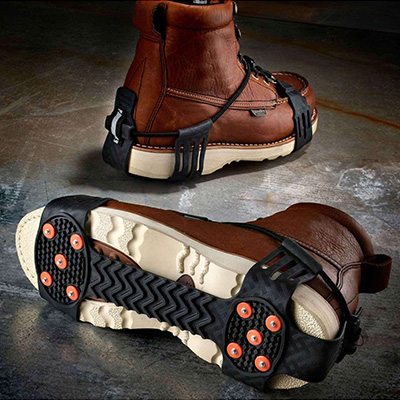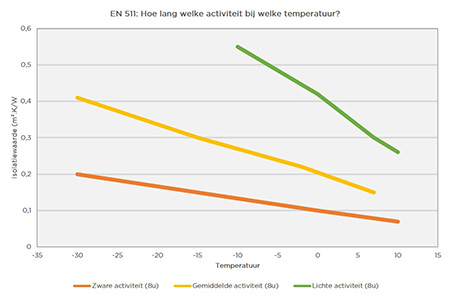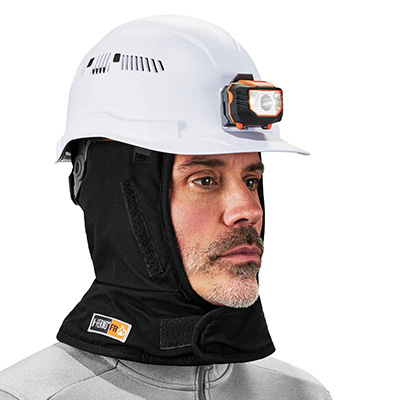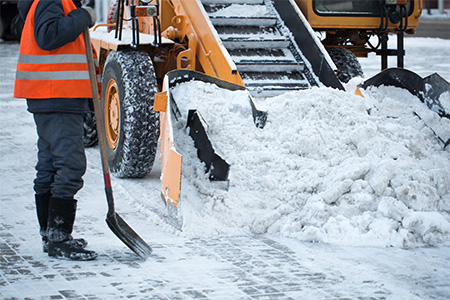
Updated 31.07.2025.
If you work outside regularly during winter days, you'll soon need to keep warm. To stay comfortable during the working day, we'd like to give you these 8 tips to keep yourself warm.
General precautions to take:
- Make sure you have the right work clothing and personal protective equipment
- Provide hot drinks
- Use tools to reduce physical strain
- Adjust your work schedules
- Limit your working time in cold environments
- Limit the airflow in, for example, cold stores
#1 Warming packs
You've probably used them before. Break the pack, put the warming packs in your winter gloves, in your headgear or even in your winter boots and you are ready to face the cold! Simple! They give off natural heat for up to 10 hours as soon as you break the pack.
What's more, there are also heated garments to keep you extra warm. Consider the ultrasonic heated tunnel jacket, with carbon fibre panels for hours of warmth, the heated body warmer, which keeps you warm using a battery, and battery-powered heated socks.

#2 Ice sports: more grip and stability
One of the most common risks during winter weather is skidding on slippery surfaces. With ice tracks, you create greater stability and traction on snow or ice. Logistics workers, postmen or courier services will certainly feel the benefit!
You put them on around your work boots, adjust them to your size and they will last flexibly down to -40°C.
Ergodyne T-REX ICE 6310 ice tracks

#3 Warm winter gloves
Don't be fooled by winter work gloves that are not cold-resistant. What you certainly don't want is a glove that absorbs moisture, allowing the cold to seep in.
This is how to spot good winter work gloves
- They comply with EN 511: Protective gloves against cold.
- The lining consists of acrylic, fleece or another thermal fabric
- Finger-sensitive and flexible to work with
- They continue to protect you from risks of cuts, abrasions or tears.
How long can you work outside with winter work gloves?
It depends on your type of activity, how long you work outside and the outside temperature.

If you're doing heavy work all day, the insulation value may be lower and EN 511 Class 1 will often suffice. For activities where you make less physical effort and stand still for longer periods, you are more likely to need gloves with a high insulation value.
#4 Keep your head cool... or warm perhaps?
Did you know you can get headaches from extreme cold? Biting cold wind makes the muscles in your head contract, which you feel, especially in the front. Wearing the right headgear will prevent this type of headache.
For short jobs, a (balaclava) hat is sufficient, but what if you wear a helmet?
- Helmet liners (bonnets)
- Winter bump caps
- Layering system in combination with your safety helmet
- Buff
Helmet liners/bonnets
The difference with regular liners or bonnets is that helmet liners fit snugly under your helmet. They come in short, long and even flame-retardant models.
Remember those warming packs? Helmet liners often feature a small opening for heating packs.

Winter impact caps
Winter bump caps feature a fleece fabric and ear flaps to keep your head and ears nice and warm.
Modular system in combination with your safety helmet
Just as with clothes, you can also work with layers on your head. Centurion have developed CWHS (Centurion Weather Hood System) a modular system to protect your head, neck and face from extreme cold:
- A universal fleece liner, perfect for combining with all their safety helmets.
- A neck warmer that protects your neck from cold and rain. Just zip it to your safety helmet and that's it!
- A face warmer that you attach to the neck warmer with Velcro strips.
Buff
Buff® has some clever products for professionals, too. The tube neck warmer can be worn in numerous ways and is adapted to the risks in the workplace (anti-static, fire-retardant, reflective,...).
#5 Warm feet
For warm shoes or boots, look at the model and material (inside and outside).
Here are our top tips:
- A plastic sole is warmer than a steel sole. The same goes for the protective toe-cap.
- A thermal lining keeps your feet warm for longer.
- Are you standing in water? Go for a boot in synthetic material such as PVC.
- A warm, moisture-regulating sock makes a big difference.
- Are there employees who have to work in extreme cold? Then look out for a cold-insulating sole (marked by the abbreviation CI).
Padded work boots or a shoe with a fleece insole will keep your feet nice and warm. There are also warm winter socks and winter insoles made of 100% wool, which keep your feet warm and comfortable naturally, even during the coldest days.
In this article, you will read more about how to choose the perfect winter work boot.

#6 Don't forget the emergency shower
An emergency shower is vital at locations where you could come into contact with hazardous substances. And especially when it is freezing, it is important that your emergency shower is frost-proof.
There are two ways to keep it frost-free.
- An electric heating cable prevents the pipes from freezing by placing it around or near the water pipe.
- You could also use an underground water connection, where the water is connected at a depth of approximately 36" (approx. 97cm). The water cannot freeze at this depth.
#7 Protect and care for your skin
Moisturising your skin and hands with a caring cream is important, especially in cold temperatures and dry air. Dry or irritated skin can not only feel unpleasant, but also crack or become sensitive more quickly. So, use a good hand and skin cream regularly, specially designed to protect as well as repair the skin.
#8 Layering
If you are still wearing one very thick winter coat, then we would like to introduce you to the layering principle. Simple and convenient in changing temperatures. Your work outfit will be a lot more flexible, and you'll be able to add or take away layers as and when required. Compose your own layers and come up with the perfect combination.
The layering principle is nothing more than dressing in three layers:
- Thermal base layer
- Insulating middle layer
- Protective outer layer
Thermal base layer
A warm base layer will get you off to a good start.
We recommend wearing thermal clothing such as thermal underwear. Their properties ensure that sweat is wicked away to the outside so your skin stays dry. Look especially for terms like moisture-wicking.
So what material should that underwear be made of? You have two options: synthetic fibres or wool. Thermal underwear based on polyester, Viloft® or polypropylene are ideal as a budget-friendly base layer.
Wool , on the other hand, is the absolute best. It is a 100% natural fibre that has proved its worth in cold conditions for centuries. Wool has a unique structure that makes it retain heat even when it gets damp. Moreover, it is breathable and regulates your body temperature: you stay warm without overheating or sweating. Added bonus: wool is naturally antibacterial, which means it keeps odours at bay and keeps your underwear fresh for longer.
If you go for wool, choose a merino. Thanks to its fine texture, it feels soft and does not itch. ... and wear this layer tightly against the skin. This will allow the clothing to do its job and keep you warm and dry.

Insulating middle layer
Above your thermal base layer, you can add a cold-insulating middle layer. The function of this layer is to retain your body heat. Moreover, such a layer also works when it gets too hot. You decide whether to dress lighter or heavier.
Choose a windproof fleece, or a softshell. Both materials help you stay warm by blocking wind and keeping warmth close to your body. Yet each has its own advantages:
- Fleece: Soft, light and retains body heat well. Excellent breathability, but less resistant to wind and rain. A windproof fleece therefore has an extra layer that blocks wind.
- Softshell: Combines warmth with a sturdy outer layer that is wind- and often water-repellent. Ideal if you are active in the cold and are looking for protection from changing weather conditions.

Protective outer layer
In rain, wind or cold temperatures, you need a good outer layer. Protect yourself against these elements with a waterproof but breathable raincoat. According to EN343 standards, workwear is tested for three main properties:
- Waterproof: This keeps you dry and prevents rain or snow from getting in.
- Windproof: This way, you feel less cold because the wind cannot pass through the fabric.
- Breathable: For optimum comfort. While moving or working, you will sweat. If that moisture cannot get out, your jacket will get wet inside, which actually causes cooling.
So a jacket that scores well on these three points provides the perfect balance between protection and comfort.

Want the cream of the crop? Then go for a mackintosh with a breathable membrane, such as GORE TEX® or Sympatex®, which will keep you dry while allowing moisture to escape. For a more budget-friendly alternative, consider a coated jacket. Note that these jackets are waterproof but not breathable, which can make you feel hot and clammy faster when working.
Many manufacturers combine outer layer and mid-layer in one product, for example a mackintosh with softshell or sleeves that you can unzip. This allows you to adjust layers according to the temperature: remove a softshell, fleece or body warmer from your jacket when it gets too warm, and zip it back in when it gets colder. Handy!
There are also thick jackets that insulate so well by themselves that they take over the function of the middle layer. If you opt for a three-layer system, you can actually choose a thinner outer shell, so that you remain more flexible in combining layers and respond more easily to changing temperatures.
Now you can start the crisp winter morning with your chosen layers and take them on or off whenever you want.
Additional tips for cold and wet winter days
Besides the usual layers of clothing, winter boots and warming packs, there are a number of useful tools to stay safe and comfortable during cold, dark winter days:
- Signal vests with LED lights: Ideal for days with low daylight, keeping you highly visible at work or on the go.
- Lamps for helmets or other lighting: Useful for early or late shifts, when it is also sometimes dark during the day.
- Signage: Use signs or markers to indicate slippery spots.
- Road salt: Ensure business premises and footpaths are kept ice- and slippery-free for extra safety.
Conclusion
Above all, remember to keep yourself warm and dry. Water is your biggest enemy.
Try not to dress too warmly either, as this will cause you to perspire and so condensation will soon make you cold again too.
Choosing the right winter selection of PPE is crucial to working comfortably and safely. Order on time to make sure the necessary products are in stock.
